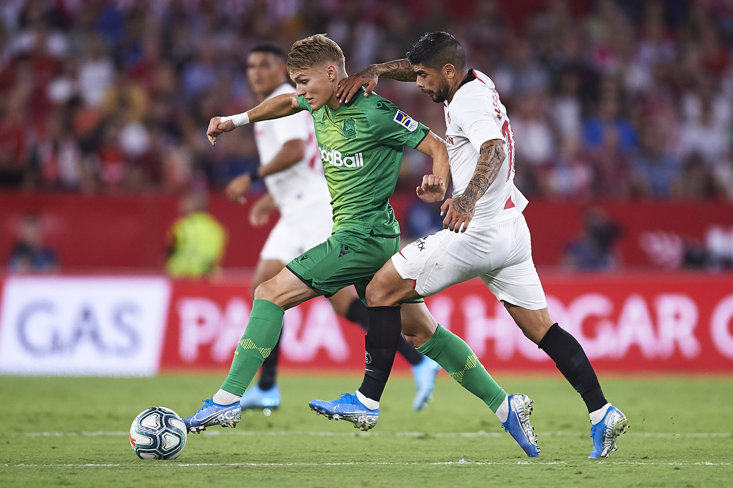Martin Odegaard has been showing up his seniors since signing for Stromsgodset at the age of 10. At 11 he was playing against 13 and 14-year-olds, and by 12 he was in the under-16s. He was 13 when he first started training with the first team, and he was a regular visitor to the likes of Bayern Munich and Manchester United as his career plan was being mapped out before him.
This was a kid destined for superstardom.
He made his Stromsgodset debut at 15, and just four months later was a Norway international for the first time, becoming the youngest player ever in the Tippeligaen and also the youngest to play for the national team. “It’s incredibly huge to realise the dream that I’ve had since I was very, very small,” Odegaard told MAX after his Norway debut against United Arab Emirates. “I didn't think I’d start at all, so to play 90 minutes is good.”
READ MORE:
-
Arteta's Side Showing Style And Substance In Shock Title Push
- Fresh, Firing Liverpool Have Plenty More To Come
His playmaking qualities made him the star attraction in a Stromsgodset side which qualified for the Europa League, schooling players twice his age with his magical left foot and mature-beyond-his-years approach to being all anybody in Norway could talk about. It felt like the whole world was just waiting for Odegaard to explode on the big stage, with Man Utd, Bayern, Barcelona and Juventus jostling for position in the queue to land his signature.
It was Real Madrid who eventually snapped him up in January 2015, only a month after he’d turned 16. Slotting immediately into Real Madrid Castilla, the club’s reserves, he was expected to continue his career arc at the Santiago Bernabeu to become a teenage whiz kid in the famous white kit.
And yet that never happened. Instead of a constant elevation, Odegaard’s time at Real Madrid was ultimately one of frustration on a personal level. While he made his Madrid debut as a 16-year-old substitute for Cristiano Ronaldo on the final day of the 2014-15 season, it would take him another 18 months to make his first start and even after successful loan stints at the likes of Heerenveen, Vitesse and Real Sociedad he just couldn’t break into the Madrid line-up.

Perhaps it was that the Blancos had a superb midfield triumvirate of Casemiro, Toni Kroos and Luka Modric that Odegaard never really found his feet in the Spanish capital. Maybe it was that the Norwegian didn’t have the patience to turn his talent into a game-changing quality in an already-successful team.
Whatever it was, Odegaard ended up making just 11 first-team appearances in seven years as a Real Madrid player under seven different coaching spells for five separate managers. No matter who was in charge, what the make-up of the first XI was, or which players had been shipped in and out in any given season, Odegaard just couldn’t make an impression.
To those neutrals of a casual persuasion, Odegaard’s name was now sitting in a similar category to the likes of Freddy Adu and Hachim Mastour; teenage superstars tipped for the top but destined to live a nomadic life away from the spotlight.
But that’s where Arsenal came into the equation. The Gunners had been one of the countless clubs chasing his signature back when he was a 15-year-old weighing up his options, and when Madrid showed an interest in loaning him out again for the second half of the 2020-21 season the north London side finally got to stick the red shirt on Odegaard’s back.
Under Mikel Arteta, Odegaard has absolutely come to life. In a side playing under the radar during a time of transition, he immediately slotted into Arteta’s way of working. While bigger names in the set-up were struggling to play their best under the Spaniard, Odegaard gradually grew to become one of Arsenal’s most regular performers.

By the summer, it was clear to all parties that it was best for Odegaard to sign permanently with Arsenal for £30 million. For the first time since his Stromsgodset days, the attacking midfielder had found a home, and for Real Madrid it made sense to offload a player who had a decent market value, especially since they had still never found a regular place for him in their line-up.
After a sparkling 2021-22 campaign during which Odegaard played more games at senior level than he’d ever previously managed, he was named Arsenal’s club captain. And under his leadership, the club who have gone 19 years without a league title are hurtling towards the turn of the year with a seven-point lead after another Odegaard-inspired victory against West Ham United on Monday. He passes, he presses, he leads and he hunts. He has everything in his game that a team could wish from their playmaker.
Having only just turned 24, Odegaard’s is a story which has plenty of longevity still in it. It seems remarkable that a player so young has been a household name for near-on a decade, and yet the maturity and experience that oozes out of every performance speaks to his having soaked up every last ounce of knowledge from the various highs and lows of his career so far.
Nobody counted on Arsenal having such a wonderful start to the season, and fewer still probably believed that Odegaard could bounce back from his Real Madrid travails. But Martin Odegaard is now every bit the wonderful attacking superstar he had threatened to become.